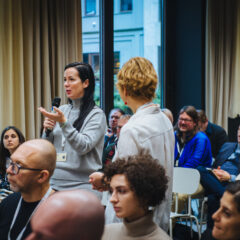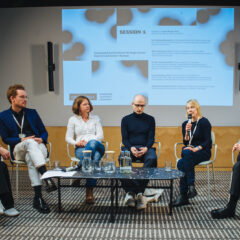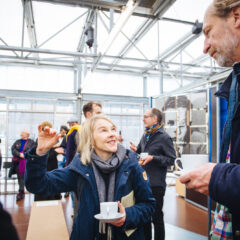
Convergences and Divergences, Conference and Side-Events, © Collage: Ben Buschfeld, Photos: Grzegorz Karkoszka, 2023
Convergences and Divergences. Modernism beyond East and West
Conference: 16.11.2023–18.11.2023
The conference addresses the history of modern architecture from a horizontal and non-hierarchical perspective, overcoming outdated and simplistic categories such as East and West. It will focus not only on design and urban planning issues, but also on questions related to the transformation of societies, the exchange of ideas, the building of relationships between people or the struggle for a better future. The conference approaches architecture from a broader perspective – presenting it as a „seismograph“ of the visionary and at the same time ambivalent experience of Modernism, which has much to say not only about the particular moment in history but also about the present.
For too long, theoretical and political constructs have contributed to a territorial or thematic marginalization of Central and Eastern Europe in European architectural historiography. Instead, the conference encourages a closer look at the dynamics between and beyond the political, geographical and cultural borders of Europe in the 20th and 21st century. The aim is not only to analyze the differences, but also to write a history of connections in modern architecture, employing a range of scales and approaches: focusing on timeframes and milestones, exploring cities, regions and borders where histories and memories meet, as well as examining architecture from the perspective of individual stories – those behind biographies or those behind particular architectural objects and ideas of Modernism.
The conference will bring together various perspectives and areas of expertise represented by researchers, architects, designers, architectural historians, urban activists and civic society actors. The main goal is to critically rethink the legacy of Modernism and its associated transformations in Central and Eastern Europe in the context of international relations, dependencies, influence, and power. The conference builds on the five-year experience of the “Exercising Modernity” program – an interdisciplinary intellectual exchange on art and architecture in a broader sense, exploring how ideas of modernity were reflected in various social and political spheres – and is being organized in cooperation with the initiative for a “European Triennial of Modernism (ETOM)”.
Program schedule
16.11.2023 DAY 1 – Convergences and Divergences. Modernism beyond East and West
08:45 – 9:30 Registration
09:30 – 10:00 Welcome speeches
Christoph Rauhut, Berlin Monument Authority, State Conservator
Małgorzata Jędrzejczyk, Pilecki-Institute Berlin, Head of Exercising Modernity Program
Hanna Radziejowska, Director of the Pilecki-Institute Berlin
Robert K. Huber & Ben Buschfeld, Curators of ETOM – European Triennial of Modernism, TDM-Berlin
10:00 – 12:00 Session I – Contested architectural heritage across Central and Eastern Europe
Moderator: Ingrid Ruudi, Estonian Academy of Arts in Tallinn
Christoph Rauhut, Berlin Monument Authority, State Conservator:
Karl-Marx-Allee and Interbau 1957. Architecture and Urbanism in Postwar Modernism (working title)
Marii Laanemets, Institute of Art History, Estonian Academy of Arts in Tallinn:
The intertwined history of the Linnahall. Reflections on modernity and society
Andrzej Leśniak, Institute of Literary Research, Polish Academy of Sciences:
The Parade Square between modernisation and globalization: the controversies and entangled histories on the site of the future Museum of Modern Art in Warsaw
Iryna Matsevko, Deputy Vice-Chancellor of the Kharkiv School of Architecture:
Is the Soviet Built Heritage Ukrainian? Challenges and Perspectives of the Legacy of Modernism in Shaping Postwar Ukrainian Identity
Aleksandra Sumorok, Academy of Fine Arts W. Strzemiński in Łodź:
Socialist Realist Monuments in Poland. A „difficult” heritage?
12:00 – 13:30 Lunch break
13:30 – 15:30 Session II – Iron curtain(s) of the 20th century. Modernism beyond the binary of East and West
Moderator: Jörg Haspel, ICOMOS, former State Conservator of Berlin
Błażej Ciarkowski, University of Łódź:
Looking through “a nylon curtain”. How do architects describe their international experiences in the times of socialism
Helena Huber-Doudová, National Gallery Prague:
The Typology of Architecture Practice between the East and the West in the 20th century
Vaidas Petrulis, Institute of Architecture and Constructon. Kaunas University of Technology: National Narrative without Borders: Architecture of the Lithuanian Diaspora in the USA after World War II
Denada Veizaj & Georgij Islami, Faculty of Architecture and Urbanism, Department of Architecture, Polytechnic University of Tirana:
Modernity without modernism. The particular path of architecture in Albania from 1975 to 1990
Miłosz Gortyński, Łódź University of Technology:
Open Form and Open Society in the Architecture
Ana Ivanovska, Faculty of Architecture, University Ss. Cyril and Methodius and Contineo 2020, Skopje:
Building the City of Solidarity: The case of Skopje
15:30 – 16:00 Coffee break
16:00 – 18:00 Session III – Built narratives. Multilayered identities of modern architecture
Moderator: Aleksandra Janus, Pilecki-Institute Berlin, Exercising Modernity Program Curator
Marija Drėmaitė, Faculty of History, Vilnius University:
Is there East Central European Modernism? The multifaceted case of Kaunas Modernism (1919-1939)
Jasna Galjer, Faculty of Humanities and Social Sciences, University of Zagreb:
Lost or found? Utopia and reality of modernism in the croatian architecture of the socialist and post-socialist period
Almantas Samalavičius, Department of Architectural Fundamentals, Theory and Art, Vilnius Giediminas Technical University:
Behind the Curtain – Reception and Integration of Modernism(s) in Lithuanian Architectural Discourse During the Later Soviet Era (1970-1990)
Svitlana Smolenska, Department of Construction, Architecture and Design, Kherson State Agrarian and Economic University, visiting researcher at TH OWL:
International competition 1930 in Kharkiv, Ukraine – Modernism beyond the binary of East and West
Katarzyna Solińska, Voivodeship Monuments Protection Office in Krosno:
Tracing papers. Lost archives and forgotten narratives – hidden and silenced microhistory of the “Deaf German” architect, his Trans-Olza opponent and Modernism beyond Subcarpathian Region
18:00 – 18:30 Coffee break
18:30 – 20:30 Keynote lecture 1 – with talk and Q&A
Moderator: Robert K. Huber, BHROX bauhaus reuse / zukunftsgeraeusche GbR, ETOM, TDM-Berlin
Ákos Moravánszky, Theorist and Historian, ETH Zurich, Institute for the History and Theory of Architecture:
Shifting Grounds – Re-Mapping the Historiography of Architectural Modernism in Europe
20:30 – 22:30 Get together
17.11.2023 DAY 2 – Convergences and Divergences. Modernism beyond East and West
09:30 – 10:00 Registration
10:00 – 12:00 Session IV – Shared heritage. Points of contact and best practices
Moderation: Uta Pottgiesser, Docomomo International, TH-OWL, TU Delft Heritage & Technology
Alex Bykov, Architect and activist, Kyiv:
#SAVEKYIVACTIVISM
Marcin Lachowski, Institute of Art History, University of Warsaw:
The history and utopia of modernism in the narratives of contemporary Polish artists
Louis Volkmann & Ben Kaden:
Isn’t the new post office beautiful? Picture postcards as visual and textual testimonies of Eastern Modernism
Julia Bojaryn, Stiftung Haus Schminke, Löbau:
TBC – About TOPOMOMO – continuation of a cross-national cooperation project (WT)
Daniel Kovács, Hungarian Museum of Architecture and Monuments Protection Documentation Center / The Hungarian Contemporary Architecture Centre (KÉK), Budapest:
Promoting Modernism, with Women’s Stories
12:00 – 13:30 Lunch break
13:30 – 15:30 Session V – New Communities, New Buildings, New People: the notion of the “new” in Central and Eastern European modern architecture
Moderator: Ben Buschfeld, buschfeld.com, ETOM, TDM-Berlin
Nadiia Antonenko, Department of Information Technologies in Architecture, Kyiv National University of Construction and Architecture:
Large-scale housing estates in Ukrainian cities of the 1960s-1980s – A new look at value in the context of the war
Małgorzata Burkot, Independent researcher:
100 schools in Vilnius region
Kateryna Didenko, Department of Architecture, Vilnius Technical University:
Fundamentals of the KhNUCEA – Laboratory for the information of a new soviet man. The case study early-modern architecture of residential complexes in the metropolitan Kharkiv
Piotr Woliński, Łódź University of Technology:
Transfer of modernism and planning of post-war Warsaw and Singapore. Relationships and circumstances of building “new” states, cities, societies.
Michal Wisniewski, Instytut Architektury and International Culture Center Krakow:
When the new is becoming old – the case of postwar housing in Poland
15:30 – 16:00 Coffee break
16:00 – 17:30 Keynote lecture 2 – with talk and Q&A
Moderator: Robert K. Huber, BHROX bauhaus reuse / zukunftsgeraeusche GbR, ETOM, TDM-Berlin
Henrieta Moravčíková, STU Bratislava, Slovak Academy of Science, Docomomo Slovakia:
Tests of perspective – architectural histories of a vague country
17:30 – 18:00 Coffee break
18:00 – 20:00 Lessons learned – Panel discussion
Moderator: Małgorzata Jędrzejczyk, Pilecki-Institute Berlin, Ben Buschfeld & Robert K. Huber, ETOM, TDM-Berlin
Special-Input:
Tino Mager, ICOMOS Germany, History and Theory of Architecture and Urbanism, University of Groningen: Contentious Spaces – Uncovering the Hidden Narratives of Socialist Built Heritage
Edward Denison, The Bartlett School of Architecture:
Modern Heritage in the Anthropocene and the need for the Cape Town Document on Modern Heritage
Edward Denison, The Bartlett School of Architecture
Maja Babić, Theory of Architecture and Urbanism at the University of Groningen
Franziska Bollerey, TU-Delft, Institute of History of Art, Architecture and Urbanism, Delft-Berlin
Kacper Kępiński, National Institute of Architecture and Urban Planning, Warsaw
21:00 – 23:00 Dinner with panelists (all speakers and invited guests)
18.11.2023 DAY 3 – Network brunch & Exhibition SOFT GROUND – Exercising Modernity
Attention – different venue: BHROX bauhaus reuse, Ernst-Reuter-Platz (central traffic island)
10:30 – 12:30 Soft Ground – Excercising Modernity
Networking brunch & exhibition curatorial guided tour
Side Events:
12:30-13:30 Recommended Side Event I
Exhibition by Prof. Svitlana Smolenska:
Hans Poelzig’s Project for Ukraine. The International Competition 1930 for the State Ukrainian Theatre in Kharkiv
Venue: Architekturmuseum TU Berlin (meeting at 12:30 at BHROX bauhaus reuse, Ernst-Reuter-Platz)
More information: www.architekturmuseum.ub.tu-berlin.de
13:00-20:00 Recommended Side Event II (in German language only)
Colloquium by the Hermann-Henselmann Foundation:
Bruno Flierl – Planen und Streiten für die Berliner Mitte (Planning and Arguing for the Center of Berlin)
Venue: Rosa-Luxemburg-Stiftung / Saal 11, Str. der Pariser Kommune 8 A, 10243 Berlin (for directions and transport see “Practical information”)
More information: www.hermann-henselmann-stiftung.de
14:00-16:30 Optional Side Event III (follwoing Side Event I, for only English speaking audience)
Architectural tour by Ben Buschfeld:
The Hufeisensiedlung in Neukölln-Britz – Tour through the UNESCO World Heritage Berlin Modernism Housing Estates, including a visit of the rentable 1920s museum Tautes Heim
Venue: meeting at 14:00 at BHROX bauhaus reuse (tour starts 14:45 at subway U7 station “Blaschkoallee”, exit “Fritz-Reuter-Allee”)
The conference program is shaped along the following five topic areas:
Panel – section 1:
Contested architectural heritage across Central and Eastern Europe
Objects, sites or typologies of compromised or ambivalent history are often referred to as contested, difficult or problematic heritage. All these terms attempt to capture the social resonance of or responsibility for our cultural legacy. This often results in that heritage being excluded from social circulation and appreciation, because from today’s perspective, it is perceived as evidence of a shameful or painful past that has been successfully overcome.
Both rejection of a fragment of the past and the abandonment of care can lead to a gradual decay or even invite active processes of aesthetic devaluation or de facto destruction. The reason may be that such heritage is judged unsuitable by a majority society, a defined group, or the political administration to tell a positive, unifying story about itself or is perceived as “alien”.
The section presents examples of such ambivalent heritage and for contemporary socio-cultural practices in dealing with it – in particular as regards current challenges of post-Soviet traces in modern architecture in Central and Eastern Europe.
Panel – section 2:
Iron curtain(s) of the 20th century. Modernism beyond the binary of East and West
This section explores the reception and migration of designs and ideas across various divisions that accompanied the Iron Curtain. Rather than focusing on a one-way flow from the center to the periphery, the interest is on a ‘moving map’. Vectors of exchange between West and East are oriented in many ways and directions. The goal is to challenge unidirectional or vertical historical architectural narratives that are often based on the principle of subordination of Central and Eastern European architecture.
The section aims to trace disconnected histories and obscure biographies. Particular attention will be given to the question, how did ideological and geopolitical rifts and tensions reinforce the demarcation between the notions of Eastern and Western European Modernism? How did they contribute to the suppression or neglect of certain narratives, design principles, and individual stories? How may ideologically motivated exacerbations have hindered or re-channeled the transfer of ideas?
The panel discusses examples of biographies or activities that, despite political or ideological barriers, facilitated the flow of ideas and concepts between East and West or West and East – with a particular focus on countries of Central and Eastern Europe and East and West Germany.
Panel – section 3:
Built narratives. Multilayered identities of modern architecture
Architectural heritage is often used to tell stories about particular versions of the past. In geographical and cultural areas where multiple groups have lived together and various political spheres have intersected, built heritage may consist of numerous historical layers and witness many deliberate aesthetic redesigns. For various reasons, these are not – or have not been made – equally visible.
The section focuses on examples of architectural heritage that bear witness to multicultural and multilingual histories, as well as for examples of successful policies and practices. How can plurality be expressed and made accessible through conservation, storytelling, activism, and artistic intervention?
Panel – section 4:
Shared heritage. Points of contact and best practices
The notion of shared built heritage unveils the hidden networks and the potential for sharing (architectural) history by various communities, nations, regions and countries.
On the other hand, this concept revives sources and risks of tension, as a result of which joint or in-depth exploration is sometimes neglected.
This section is dedicated to strategies for making the public, local communities, authorities and professionals aware of the importance of shared modern history. This includes the same or similar guiding principles, roots, characteristics and design features in modern architecture in Central and Eastern Europe.
The panel discusses examples of practices of revitalization, rehabilitation, conservation, documentation, communication and management pertaining to common architectural heritage, with a special focus on the collaboration between various actors involved.
Panel – section 5:
New Communities, New Buildings, New People: the notion of the “new” in Central and Eastern European modern architecture
Housing is an important part of architectural history, but it also plays a major role in the history of political, social and spatial changes of a particular era. Especially the ideas of social and communal living were labeled “new” at the beginning of the 20th century, when they began to shape cities and social life in various parts of the continent. How did these ideas develop in the first and second half of the 20th century in both East and West?
The panel focuses on centers of change that show diverse developments and layers based on their political history, shifts of borders, migrations and cultures of exile, to examine individual traces, shared models and differences that need to be addressed.
Based on selected case studies, the section discusses examples from polycultural cities such as Berlin, Prague, Kharkiv, Kyiv, Warsaw, Tallinn and Vilnius. Of special interest are significant examples of modern housing settlements for which the initial ideas can be juxtaposed with the present situation and contemporary challenges.
The conference is organized by the Pilecki-Institut Berlin in cooperation with ETOM initiative, zkg/BHROX and buschfeld.com and is supported by the Foundation for Polish-German Cooperation and Lithuanian Embassy in Berlin.
The conference is co-financed by the Foundation for Polish-German Cooperation.
The conference is featured by the “Triangle for Modernism” which is a cooperation between ETOM, DOCOMOMO International and ICOMOS.
Participation in the conference is officially recognized by the Architektenkammer Berlin (and assessed with a total of 16 teaching units, 1 UE = 45 minutes – 8 teaching units on 16.11.2023 and 8 on 17.11.2023)
Download CaD Brochure (1,7 MB, PDF)

Conference: Convergences and Divergences, © Graphic: Pigalopus, 2023
![]()






















































